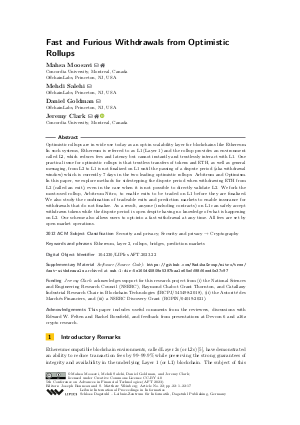Fast and Furious Withdrawals from Optimistic Rollups
Authors
Mahsa Moosavi,
Mehdi Salehi,
Daniel Goldman,
Jeremy Clark 
-
Part of:
Volume:
5th Conference on Advances in Financial Technologies (AFT 2023)
Part of: Series: Leibniz International Proceedings in Informatics (LIPIcs)
Part of: Conference: Advances in Financial Technologies (AFT) - License:
 Creative Commons Attribution 4.0 International license
Creative Commons Attribution 4.0 International license
- Publication Date: 2023-10-18
File

PDF
LIPIcs.AFT.2023.22.pdf
- Filesize: 0.83 MB
- 17 pages
Document Identifiers
Subject Classification
ACM Subject Classification
- Security and privacy
- Security and privacy → Cryptography
Keywords
- Ethereum
- layer 2
- rollups
- bridges
- prediction markets
Metrics
- Access Statistics
-
Total Accesses (updated on a weekly basis)
0PDF Downloads0Metadata Views
Abstract
Optimistic rollups are in wide use today as an opt-in scalability layer for blockchains like Ethereum. In such systems, Ethereum is referred to as L1 (Layer 1) and the rollup provides an environment called L2, which reduces fees and latency but cannot instantly and trustlessly interact with L1. One practical issue for optimistic rollups is that trustless transfers of tokens and ETH, as well as general messaging, from L2 to L1 is not finalized on L1 until the passing of a dispute period (aka withdrawal window) which is currently 7 days in the two leading optimistic rollups: Arbitrum and Optimism. In this paper, we explore methods for sidestepping the dispute period when withdrawing ETH from L2 (called an exit), even in the case when it is not possible to directly validate L2. We fork the most-used rollup, Arbitrum Nitro, to enable exits to be traded on L1 before they are finalized. We also study the combination of tradeable exits and prediction markets to enable insurance for withdrawals that do not finalize. As a result, anyone (including contracts) on L1 can safely accept withdrawn tokens while the dispute period is open despite having no knowledge of what is happening on L2. Our scheme also allows users to opt-into a fast withdrawal at any time. All fees are set by open market operations.
Cite As Get BibTex
Mahsa Moosavi, Mehdi Salehi, Daniel Goldman, and Jeremy Clark. Fast and Furious Withdrawals from Optimistic Rollups. In 5th Conference on Advances in Financial Technologies (AFT 2023). Leibniz International Proceedings in Informatics (LIPIcs), Volume 282, pp. 22:1-22:17, Schloss Dagstuhl – Leibniz-Zentrum für Informatik (2023)
https://doi.org/10.4230/LIPIcs.AFT.2023.22
BibTex
@InProceedings{moosavi_et_al:LIPIcs.AFT.2023.22,
author = {Moosavi, Mahsa and Salehi, Mehdi and Goldman, Daniel and Clark, Jeremy},
title = {{Fast and Furious Withdrawals from Optimistic Rollups}},
booktitle = {5th Conference on Advances in Financial Technologies (AFT 2023)},
pages = {22:1--22:17},
series = {Leibniz International Proceedings in Informatics (LIPIcs)},
ISBN = {978-3-95977-303-4},
ISSN = {1868-8969},
year = {2023},
volume = {282},
editor = {Bonneau, Joseph and Weinberg, S. Matthew},
publisher = {Schloss Dagstuhl -- Leibniz-Zentrum f{\"u}r Informatik},
address = {Dagstuhl, Germany},
URL = {https://drops.dagstuhl.de/entities/document/10.4230/LIPIcs.AFT.2023.22},
URN = {urn:nbn:de:0030-drops-192112},
doi = {10.4230/LIPIcs.AFT.2023.22},
annote = {Keywords: Ethereum, layer 2, rollups, bridges, prediction markets}
}
Author Details
Funding
- Clark, Jeremy: acknowledges support for this research project from (i) the National Sciences and Engineering Research Council (NSERC), Raymond Chabot Grant Thornton, and Catallaxy Industrial Research Chair in Blockchain Technologies (IRCPJ/545498-2018), (ii) the Autorité des Marchés Financiers, and (iii) a NSERC Discovery Grant (RGPIN/04019-2021).
Acknowledgements
This paper includes useful comments from the reviewers, discussions with Edward W. Felten and Rachel Bousfield, and feedback from presentations at Devcon 6 and a16z crypto research.
Supplementary Materials
-
Software (Source Code)
https://github.com/MadibaGroup/nitro/tree/fast-withdrawals
browse
 archived version
archived version
References
-
Jeremy Clark, Joseph Bonneau, Edward W Felten, Joshua A Kroll, Andrew Miller, and Arvind Narayanan. On decentralizing prediction markets and order books. In Workshop on the Economics of Information Security (WEIS), volume 188, 2014.

-
Didem Demirag and Jeremy Clark. Absentia: Secure multiparty computation on ethereum. In Workshop on Trusted Smart Contracts (WTSC), pages 381-396. Springer, 2021.

-
Bryan Ford and Rainer Böhme. Rationality is self-defeating in permissionless systems. Technical Report cs.CR 1910.08820, arXiv, 2019.

- Nomic Foundation. Hardhat. https://hardhat.org, October 2022. (Accessed on 10/18/2022).
- Lewis Gudgeon, Pedro Moreno-Sanchez, Stefanie Roos, Patrick McCorry, and Arthur Gervais. Sok: Layer-two blockchain protocols. In Financial Cryptography, 2020. URL: https://doi.org/10.1007/978-3-030-51280-4_12.
-
Larry Harris. Trading and exchanges: market microstructure for practitioners. Oxford, 2003.

-
John Hull, Sirimon Treepongkaruna, David Colwell, Richard Heaney, and David Pitt. Fundamentals of futures and options markets. Pearson Higher Education AU, 2013.

-
Harry Kalodner, Steven Goldfeder, Xiaoqi Chen, S Matthew Weinberg, and Edward W Felten. Arbitrum: Scalable, private smart contracts. In USENIX Security Symposium, pages 1353-1370, 2018.

-
Patrick McCorry, Chris Buckland, Bennet Yee, and Dawn Song. Sok: Validating bridges as a scaling solution for blockchains. Technical report, Cryptology ePrint Archive, 2021.

-
Sarah Meiklejohn. An evolution of models for zero-knowledge proofs. In EUROCRYPT (invited talk), 2021.

-
Mahsa Moosavi and Jeremy Clark. Lissy: Experimenting with on-chain order books. In Workshop on Trusted Smart Contracts (WTSC), 2021.

-
Paul Sztorc. Truthcoin. Technical report, Online, 2015.

-
Louis Tremblay Thibault, Tom Sarry, and Abdelhakim Senhaji Hafid. Blockchain scaling using rollups: A comprehensive survey. IEEE Access, 10:93039-93054, 2022.

-
Alexei Zamyatin, Mustafa Al-Bassam, Dionysis Zindros, Eleftherios Kokoris-Kogias, Pedro Moreno-Sanchez, Aggelos Kiayias, and William J Knottenbelt. Sok: Communication across distributed ledgers. In Financial Cryptography, 2021.

